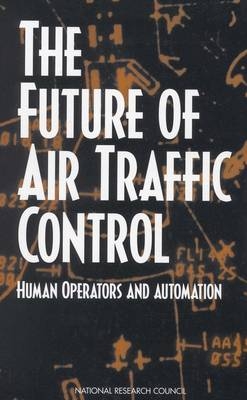
The Future of Air Traffic Control
Human Operators and Automation
Seiten
1998
National Academies Press (Verlag)
978-0-309-11161-4 (ISBN)
National Academies Press (Verlag)
978-0-309-11161-4 (ISBN)
Focuses on the interaction of pilots and air traffic controllers, with a growing network of automated functions in the airspace system. This book explores ways in which technology can build on human strengths and compensate for human vulnerabilities, minimizing both mistrust of automation and complacency about its abilities.
Automation in air traffic control may increase efficiency, but it also raises questions about adequate human control over automated systems. Following on the panel's first volume on air traffic control automation, Flight to the Future (NRC, 1997), this book focuses on the interaction of pilots and air traffic controllers, with a growing network of automated functions in the airspace system.
The panel offers recommendations for development of human-centered automation, addressing key areas such as providing levels of automation that are appropriate to levels of risk, examining procedures for recovery from emergencies, free flight versus ground-based authority, and more.
The book explores ways in which technology can build on human strengths and compensate for human vulnerabilities, minimizing both mistrust of automation and complacency about its abilities. The panel presents an overview of emerging technologies and trends toward automation within the national airspace system—in areas such as global positioning and other aspects of surveillance, flight information provided to pilots an controllers, collision avoidance, strategic long-term planning, and systems for training and maintenance.
The book examines how to achieve better integration of research and development, including the importance of user involvement in air traffic control. It also discusses how to harmonize the wide range of functions in the national airspace system, with a detailed review of the free flight initiative.
Table of Contents
Front Matter
Summary
Part I: Automation Issues and Emerging Technologies
1 Automation Issues in Air Traffic Management
2 Emerging Technological Resources
Part II: Current and Envisioned Automation of Air Traffic Control Tasks
3 Surveillance and Communication
4 Flight Information
5 Immediate Conflict Avoidance
6 Strategic Long-Range Planning
7 Support Functions
Part III: Integration
8 Integration of Research and Development
9 Airspace System Integration: The Concept of Free Flight
10 Conclusions and Recommendations
References
Appendixes
Appendix A
Appendix B
Appendix C
Index
Color Plates
Automation in air traffic control may increase efficiency, but it also raises questions about adequate human control over automated systems. Following on the panel's first volume on air traffic control automation, Flight to the Future (NRC, 1997), this book focuses on the interaction of pilots and air traffic controllers, with a growing network of automated functions in the airspace system.
The panel offers recommendations for development of human-centered automation, addressing key areas such as providing levels of automation that are appropriate to levels of risk, examining procedures for recovery from emergencies, free flight versus ground-based authority, and more.
The book explores ways in which technology can build on human strengths and compensate for human vulnerabilities, minimizing both mistrust of automation and complacency about its abilities. The panel presents an overview of emerging technologies and trends toward automation within the national airspace system—in areas such as global positioning and other aspects of surveillance, flight information provided to pilots an controllers, collision avoidance, strategic long-term planning, and systems for training and maintenance.
The book examines how to achieve better integration of research and development, including the importance of user involvement in air traffic control. It also discusses how to harmonize the wide range of functions in the national airspace system, with a detailed review of the free flight initiative.
Table of Contents
Front Matter
Summary
Part I: Automation Issues and Emerging Technologies
1 Automation Issues in Air Traffic Management
2 Emerging Technological Resources
Part II: Current and Envisioned Automation of Air Traffic Control Tasks
3 Surveillance and Communication
4 Flight Information
5 Immediate Conflict Avoidance
6 Strategic Long-Range Planning
7 Support Functions
Part III: Integration
8 Integration of Research and Development
9 Airspace System Integration: The Concept of Free Flight
10 Conclusions and Recommendations
References
Appendixes
Appendix A
Appendix B
Appendix C
Index
Color Plates
Christopher D. Wickens, Anne S. Mavor, Raja Parasuraman, and James P. McGee, Editors; Panel on Human Factors in Air Traffic Control Automation, National Research Council
| Erscheint lt. Verlag | 26.2.1998 |
|---|---|
| Verlagsort | Washington |
| Sprache | englisch |
| Maße | 152 x 229 mm |
| Themenwelt | Naturwissenschaften ► Geowissenschaften ► Geografie / Kartografie |
| ISBN-10 | 0-309-11161-7 / 0309111617 |
| ISBN-13 | 978-0-309-11161-4 / 9780309111614 |
| Zustand | Neuware |
| Haben Sie eine Frage zum Produkt? |
Mehr entdecken
aus dem Bereich
aus dem Bereich
über eine faszinierende Welt zwischen Wasser und Land und warum sie …
Buch | Hardcover (2023)
dtv (Verlag)
CHF 33,55
Buch | Hardcover (2024)
Schweizerbart'sche, E. (Verlag)
CHF 33,55
Eine Einführung in die spezielle Mineralogie, Petrologie und …
Buch | Hardcover (2022)
Springer Spektrum (Verlag)
CHF 83,95


